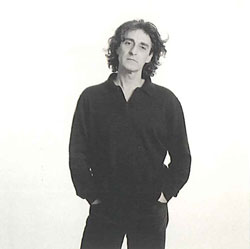Paulo Nozolino
Paulo Nozolino Lisboa ¶ 1955
 |
|
| Créditos fotográficos / Photographic credits: Abílio Leitão |
Soon after beginning his studies in Painting at the National Society of Fine Arts, he realized that his medium of choice would be photography, and so, between 1975 and 1978, he studied at the London College of Printing. Considered as one of the most important photographers of our times, there were milestones over his 30 years of career with numerous national and international awards and scholarships, such as, for instance, the Kodak Award (Portugal, 1988), the Prix Fondation Leica (France, 1989), the Villa Médicis Hors-les-Murs scholarship (Paris, 1994), and the Grand Prix de la Ville de Vevey (Switzerland, 1995). ¶ Having travelled in Europe, the United States, the North of Africa, the Middle East, India and South America, and having made Paris his home in 1989, and more recently in Porto, it does not come as a surprise that Nozolino's work has become the perfect mirror of his nomadic real-life. Related to this profile of the "road-man", the "traveller", prone to the "dérive" and a self-biographical construction that is nomadic itself, one should add his acuteness where technique and aesthetics are concerned , whether the blacks or the greys that dominate his work. ¶ Nozolino's pictures, which are always black-and-white, are loaded with the profoundest and most dramatic of poeticism, revealing shadows and spaces in which darkness is sovereign. The grain and the aesthetics of his photographs portraying interiors or urban spaces are the reverse to the most comfortable of banalities or the most exotic of elegances of the stereotypes usually reserved for the representations of actual peoples, places or moments as captured by the artist a little all over the world. The emotions gradually radiate from his images, not in any premeditated way, nonetheless insurmountably so. These are images inhabited by children, women, men, faces, gazes, but they're also directly open towards death or sex, bringing about a sense of nostalgia, discomfort, as if we're facing small fragments of a narrative. His photographs do not imply a clear, explicit story, mind you, but mere suggestions of a moment that the artist froze with his piercing gaze, very often revealing a tragic, often stark-naked vision, increasingly so in the last years, as one could notice in his retrospective exhibition Far Cry (Serralves, 2005). ¶ Therefore, one can say that Paulo Nozolino saves us from sleepwalking. Using light to reinforce darkness, the photographer works both to show us the world and to demonstrate the end of a world. The proofs he forwards are the declaration of extinction of those luminous moments.
http://cvc.instituto-camoes.pt/biografias-en/paulo-nozolino-72458.html#sigFreeId8ac189279a


